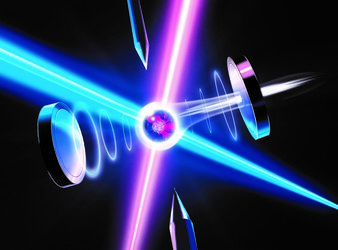Quantum computing for Moon mission materials – and much more!
Quantum computing shows a lot of promise, but we have so far lacked concrete real-world applications. Designing new materials for missions to the Moon and Mars is just one of 10 ideas that ESA has selected for potential funding to advance quantum computing and apply it to the space sector. The ideas were chosen from 23 proposed under a recent Open Space Innovation Platform (OSIP) call for ideas run by ESA Discovery, and the individuals and teams behind the ideas have now been invited to submit full research proposals.
Five of the selected ideas are driven and supported by ESA's Φ-lab, which is accelerating the future of Earth observation; one project is exploring the use of quantum computing for measuring ground motion, for example, and another for detecting clouds.

"The proposed ideas were beyond what we were expecting or had come up with at ESA," says Advanced Concepts Team member Hamish Beck, who led the call for ideas. "We even saw researchers who work on topics completely unrelated to quantum computing proposing ideas that apply this technology to their work."
"I was particularly surprised by one idea that was spot-on what we were looking for. A group of researchers from the German Aerospace Center who don't have a formal background in quantum computing proposed a study into designing materials for use and production on missions to the Moon or Mars. We are now working on the full proposals, but these types of ideas are already broadening the horizon of what can be done and clearly show the enormous creativity and know-how in this booming sector within European companies and research institutions."

For designing new materials, quantum computers offer enormous potential to improve simulations at an atomic level. Traditionally, materials can take 10 years to develop and are designed within the limited framework of existing materials and expertise. Quantum computing could enable researchers to simulate different combinations of up to 50 chemical elements for making new materials, enabling the discovery of completely new compositions in a much shorter timeframe.
The proposed and selected ideas are very diverse, spanning the entire field of quantum computing. Whilst some focus on algorithms, others propose experiments. The ideas even address different types of quantum computing, with some focusing on quantum annealing, and others on gate-based quantum computers.
ESA's Agenda 2025 defines the Agency's priorities and goals for the coming years. It highlights that quantum computing and quantum communication are key for translating big data into smart information and services. Breakthroughs in quantum technologies will also enable a new generation of sensors and clocks of unprecedented accuracy, and open up avenues to commercial success and leadership.

"The selected ideas fit nicely into ESA's Agenda 2025 and I hope that they will increase general awareness of what the future holds for quantum computing," explains Hamish. "In particular, one selected idea that is already being funded through ESA's Ariadna initiative will produce some open-source tools that will be useful for researchers working in a variety of fields."
On the use of OSIP to collect ideas, Hamish adds: "Idea authors said it was remarkably easy to submit ideas. The process is much lighter – administratively speaking – than funding proposals tend to be, and they appreciated having live feedback from evaluators to improve their ideas."















 Germany
Germany
 Austria
Austria
 Belgium
Belgium
 Denmark
Denmark
 Spain
Spain
 Estonia
Estonia
 Finland
Finland
 France
France
 Greece
Greece
 Hungary
Hungary
 Ireland
Ireland
 Italy
Italy
 Luxembourg
Luxembourg
 Norway
Norway
 The Netherlands
The Netherlands
 Poland
Poland
 Portugal
Portugal
 Czechia
Czechia
 Romania
Romania
 United Kingdom
United Kingdom
 Slovenia
Slovenia
 Sweden
Sweden
 Switzerland
Switzerland































